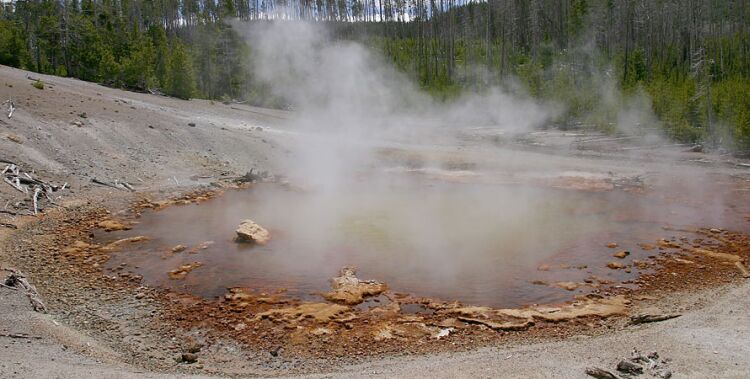
Norris Geyser Basin is one of the hottest and most dynamic of Yellowstone’s hydrothermal areas. Many hot springs have temperatures above the boiling point (200°F) here. The Carnegie Institute of Washington, D.C. made test wells in 1929 to determine subsurface temperatures. One test hole was abandoned at 265 feet when the temperature reached 401 °F and the steam pressure threatened to destroy the drilling rig.
Water fluctuations and seismic activity changes featured daily. It is hard to imagine a setting more volatile than Norris. It is part of one of the world’s largest active volcanoes. And it sits on the intersection of three major faults. One runs from the north, another one runs from the west. These two faults intersect with a ring fracture from the Yellowstone Caldera eruption 640,000 years ago. These conditions helped to create this dynamic geyser basin.
Here you can read more about this Geyser Field at the National Park Website.
Here are some of the most impressive features of Norris Geyser Field
The coordinates refer to the trailhead for the Back Basin Loop. The descriptions follow more or less a clockwise circle of the southern part of the geyser field (Back Basin and Tantalus Creek). Click the thumbnails or the links to get more pictures. Click here for an interactive map of the entire area.
Norris is home to Steamboat Geyser, the world’s tallest active geyser. Right now, it doesn’t look like anything big, but when it erupts it throws water more than 300 feet high, showering viewers and drenching the walkway.
Unfortunately, a lot of water has to build up for an eruption and there are sometimes years between major bursts.
According to Wikipedia, Steamboat’s last eruption was on May 23, 2005.
For more pictures of Steamboat Geyser click here: 1, 2,
3. |
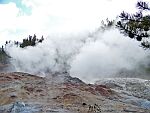
|
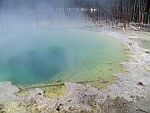 |
Cistern Spring and Steamboat Geyser are linked underground – a fact confirmed in 1983 when Cistern began emptying after each major eruption of Steamboat. While Steamboat is dormant, Cistern is a beautiful blue pool with constant overflow. Its waters deposit as much as ½ inch sinter each year and the silica-rich water of Cistern is slowly killing the trees around the spring.
For more pictures of Cistern Spring click here: 1, 2,
3. |
Echinus Geyser is named for its deposits, which look like the spines of echinoderms such as sea urchins or starfish. The red-orange color is caused by iron oxide. Echinus’ eruptions vary widely. Sometimes its bursts send waves into Tantalus Creek.
Echinus is the largest acidic geyser known; its waters are PH 3-4, almost as acidic as vinegar.
Here you can watch a short video of an Eruption, provided by Stromboli Online.
For more pictures of Echinus Geyser click here: 1,
2,
3. |
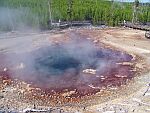
|
 |
Tantalus Creek is named after a son of Zeus. In Greek mythology Tantalus was the most prominent inmate of Tartarus, the deepest portion of the Underworld, reserved for the punishment of evildoers.
It seems like water is the smallest component of this creek. It is fed by the acid coming from Echinus and gets his bright green color from thermophile algae. The creek runs across the entire geyser field and should not be accessed. Stay on the boardwalk!
For more pictures of Tantalus Creek click here: 1,
2,
3. |

After Echinus, the trail and boardwalk take you past a number of smaller hydrothermal features. Click here to learn more about the different types of hot springs, fumaroles and geysers.
Crater Spring (More pictures 1, 2) is a small hot spring, feeding into Tantalus Creek.
Arch Steam Vent, as the name suggests, constantly vents steam. It is a fumarole, so no water can be seen here.
Puff ‘n Stuff Geyser (more pictures 1) constantly chugs and sprays, but as far as is known, it has never erupted.
Green Dragon Spring (more pictures 1) got its name for the turquoise water coming and the steam out of a sulfur-lined cave.
Blue Mud Steam Vent which began as a powerful steam vent, can still be muddy and dry – or muddy and overflowing.
Yellow Funnel Spring often is roiling and murky. It can also be calm and clear, or dry and steamy. At one time, its pool was lined with sulfur, which accounts for its colorful name.
Pearl Geyser (More pictures 1, 2, 3 and large picture below) is beautiful weather full or empty. Its eruptions can spray water eight feet high. When it is empty you can view its colorful formations and listen to its underground gurgling.
Vixen Geyser is a slightly-steaming hole in the ground. If active, you may hear gurgling below the surface and see steam rising – or you may even witness a brief, narrow and tall eruption.
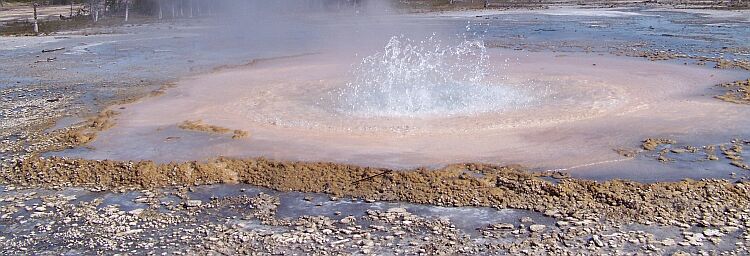
Palpitator Spring seems to be constantly beating like your heart, with large "palpitations" caused by gas bubbled dooming the surface. It has been known to drain completely for a couple of hours and then refill and begin palpitating again.
Fearless Geyser was a lot more powerful in the past. Today it spouts continuously about 1 foot above the crater.
Monarch Geyser’s eruptions in the 1880s shook the geyser basin and discharged huge amounts of water. Monarch remained active until the early 20th century. Today it just quietly overflows. (By the way, the location of Monarch shown in the geocaching map [east of the road] is wrong.)
Minute Geyser spouts vigorously 1-3 feet above its crater. It looks impressive but it is much less activity than it used to be. Minute Geyser is a sad example of human ignorance. Check our Minute Geyser Waymark to read about a sad example for humankind’s lack of understanding of the principle driving forces in nature.
( For more pictures of Minute Geyser click here: 1, 2, 3)
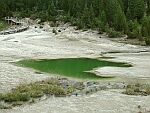 Bathtub Spring
Bathtub Spring |
Bathtub Spring and Emerald Spring are both located at the end (or the beginning) of the Back Basin Loop. They owe their colors to thermophile microorganisms living in the hot water. further north, at Porcelain Basin, you can learn more about those creatures and how they are used to estimate the temperature of a hot spring.
Click here for more pictures of Emerald Spring 1, 2, 3.
|
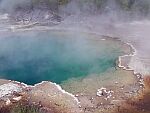 Emerald Spring
Emerald Spring |
Porcelain Basin

Porcelain Basin is the northern part of Norris Geyser Basin. It is almost as large as Back Basin (the area we just described) and has ten distinctive geysers. We didn’t have the time to check them out and here wouldn’t be enough room to introduce them. You can read about them at the National Park’s Norris Geyser Website.
Click here for more pictures of Porcelain Basin: 1,
2,
3,
4.
Notice all the different colors of the Porcelain Basin. We took a quick walk across the basin and learned that they are actually living thermometers. Here is what we learned about The Colors of Norris:
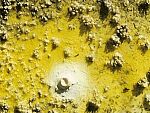 |
Yellow deposits typically contain sulfur. They form when hydrogen sulfide gas is converted to sulfur. Some thermophiles live in these areas because they use chemicals like sulfur for energy. The form communities in the hottest acidic runoff, which measure between 140°F and 181°F.
Dark brown, rust or red abound in Norris and contain varying amounts of iron. Red-brown mats may also contain bacteria and archaea that help build the mats by metabolizing and depositing iron. These iron-oxide deposits often contain high levels of arsenic. These communities often form in waters below 140°F. |

|
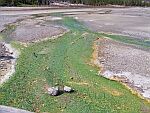 |
Emerald-green mats color many of the runoff channels of hot springs and geysers. Algae are the dominant life forms in these mats and contain chlorophyll, a green pgment that helps convert sunlight to energy. Some bacteria and archaea grow in these mats, which form below 133°F.
Dark blackish-green mats form in even cooler water. An algae called Zygogonium forms these communities. |
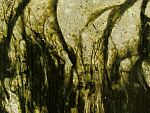 |
And with that, you have reached the end of our tour through the Norris Geyser Field.
Bernd_das_Brot Team hopes you enjoyed it!